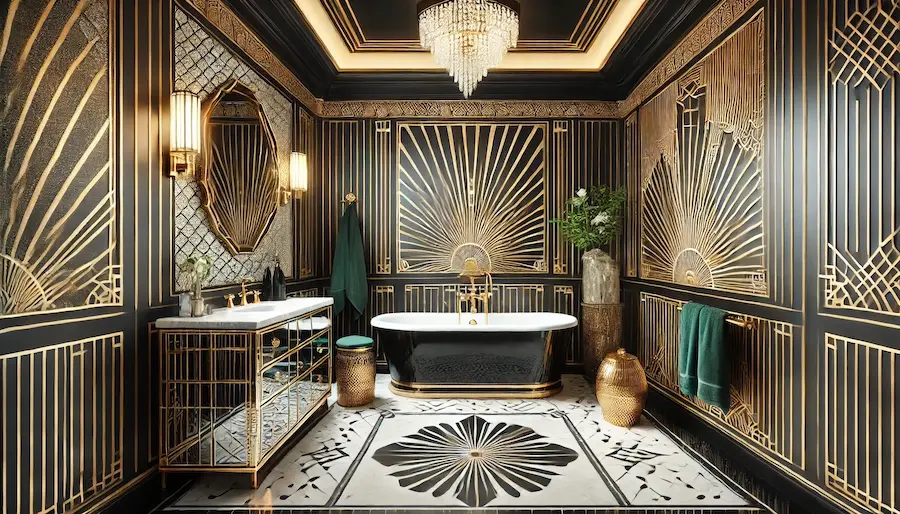Art Deco bathrooms exude timeless elegance, characterized by bold geometric patterns, luxurious materials, and a glamorous aesthetic. This article explores their origins, key features, applications, and considerations for incorporating Art Deco elements into your bathroom.
Introduction to Art Deco Bathrooms
Art Deco, short for Arts Décoratifs, emerged in the 1920s and 1930s, influencing architecture, interior design, fashion, and art. In bathrooms, this style is marked by sleek lines, symmetrical patterns, and opulent materials, creating a space that is both functional and lavish.
History and Origins of Art Deco Bathrooms
The Art Deco movement originated in France before World War I and gained international prominence in the 1920s and 1930s. It represented luxury, glamour, and faith in social and technological progress. Bathrooms designed in this era showcased innovative materials and designs, reflecting the optimism and modernity of the time.
Key Features of Art Deco Bathrooms
Incorporating Art Deco elements can transform a bathroom into a sophisticated retreat:
- Geometric Patterns: Bold shapes such as zigzags, chevrons, and sunbursts are quintessential to Art Deco design. These patterns can be introduced through tile work, flooring, or decorative accents.
- Luxurious Materials: Utilize materials like marble, chrome, glass, and lacquered wood to add opulence. For instance, a marble vanity paired with chrome fixtures epitomizes Art Deco luxury.
- Bold Color Schemes: Incorporate contrasting colors such as black and white, or deep hues like emerald green and sapphire blue, often accented with metallic tones. These palettes add drama and elegance to the space.
- Streamlined Fixtures: Choose fixtures with sleek, aerodynamic lines and symmetrical designs to capture the essence of the era. Pedestal sinks and freestanding bathtubs with curved edges are exemplary choices.
- Decorative Lighting: Install statement lighting such as chandeliers or sconces with geometric designs and frosted glass to enhance the ambiance. These fixtures provide both illumination and decorative appeal.
Applications of Art Deco Bathrooms
Art Deco bathroom designs can be adapted to various settings:
- Historic Renovations: Restoring a bathroom with Art Deco elements can honor the original architectural style of early 20th-century homes. Preserving features like original tile work or fixtures maintains historical integrity.
- Modern Interpretations: Incorporate Art Deco motifs into contemporary bathrooms to add a touch of vintage glamour. This fusion creates a unique and personalized space that bridges past and present.
- Luxury Hotels and Spas: Art Deco designs can enhance the opulence and sophistication of commercial spaces, offering guests a lavish experience. Elements like marble surfaces and ornate lighting contribute to a high-end atmosphere.
Considerations When Choosing Art Deco Bathroom Elements
When designing an Art Deco bathroom, consider the following:
- Authenticity: Incorporate genuine vintage pieces or high-quality reproductions to achieve an authentic look. Antique shops and specialized retailers can be valuable resources.
- Balance: Ensure that bold patterns and colors are balanced to prevent the space from feeling overwhelming. Pairing intricate designs with neutral backgrounds can achieve this harmony.
- Functionality: While aesthetics are important, maintain modern standards of comfort and efficiency. Integrate contemporary plumbing and lighting technologies discreetly to preserve the Art Deco appearance.
- Maintenance: Luxurious materials like marble and chrome require regular upkeep to retain their luster. Consider the maintenance demands when selecting finishes and fixtures.
Conclusion
Art Deco bathrooms offer a timeless blend of luxury and functionality, characterized by bold geometric designs and opulent materials. By understanding their origins and key features, you can create a bathroom that reflects the glamour of the early 20th century, tailored to your personal style and the architectural context of your home.
